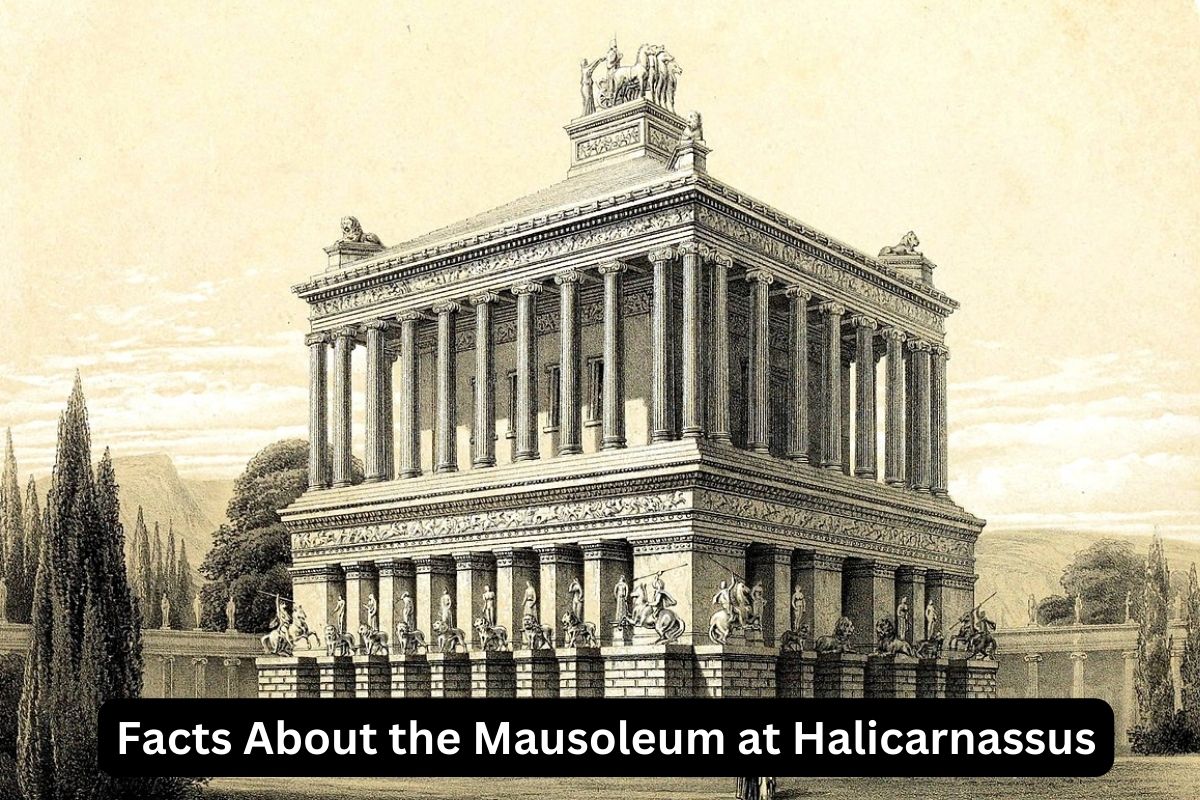The Mausoleum at Halicarnassus, built between 353 and 350 BCE, was a monumental tomb located in Bodrum, Turkey.
It was commissioned by Artemisia II as a grand memorial for her husband and brother, Mausolus, the ruler of Caria.
Designed by Greek architects Satyros and Pythius, the mausoleum combined Greek and Near Eastern architectural elements. Standing approximately 45 meters tall, it was adorned with intricate sculptures and reliefs.
The mausoleum gained worldwide fame as one of the Seven Wonders of the Ancient World and continues to be an important archaeological site, despite its partial ruin.
The Mausoleum at Halicarnassus Facts
1. Built between 353 and 350 BCE
The Mausoleum at Halicarnassus was built between 353 and 350 BCE. It was commissioned by Artemisia II as a grand burial site for her husband and brother, Mausolus, who was the ruler of Caria.
Also Read: Facts About the Lighthouse of Alexandria
The construction of the mausoleum aimed to create a lasting tribute to Mausolus’ legacy and showcase the power and wealth of the Carian kingdom.
2. Intended as a tomb for Mausolus and Artemisia II
The Mausoleum at Halicarnassus was purposefully constructed as the final resting place for Mausolus, the ruler of Caria, and his wife Artemisia II.
It was intended to serve as an elaborate tomb, symbolizing their wealth, power, and importance. Artemisia II carried out Mausolus’ vision after his death, ensuring that the mausoleum would become a lasting tribute to their legacy.
3. Designed by architects Satyros and Pythius
The mausoleum’s design was the work of two renowned Greek architects, Satyros and Pythius. They combined elements of Greek and Near Eastern architecture to create a unique and impressive structure.
Also Read: The Statue of Zeus at Olympia Facts
The influence of various architectural styles is evident in its massive scale, grandeur, and intricate detailing.
The inclusion of Satyros and Pythius as the architects of the Mausoleum at Halicarnassus highlights the significance of Greek cultural influence in the region during that era.
The Greek world, with its rich architectural tradition and skilled artisans, played a crucial role in shaping the design and execution of the mausoleum.
The collaboration between Greek architects and the Carian rulers resulted in a fusion of artistic styles and techniques, making the mausoleum an outstanding example of Hellenistic architecture.
4. One of the Seven Wonders of the Ancient World
The Mausoleum at Halicarnassus achieved worldwide fame as one of the Seven Wonders of the Ancient World. The concept of the Seven Wonders originated in ancient Greece, where various lists were compiled to celebrate exceptional architectural and artistic achievements.
The inclusion of the mausoleum on these lists helped solidify its reputation as an extraordinary and awe-inspiring structure.
5. Stood approximately 45 meters (148 feet) tall
Rising to a height of approximately 45 meters (148 feet), the Mausoleum at Halicarnassus stood as a monumental structure. Its base was a rectangular platform adorned with intricate friezes and sculptural reliefs.
The mausoleum’s upper levels consisted of a series of stepped terraces, culminating in a stepped pyramid. Atop the pyramid stood a monumental sculpture of a chariot, likely depicting Mausolus or a deified representation of him.
6. Featured intricate sculptures and reliefs
The exterior of the mausoleum was adorned with an array of sculptural decorations. Skilled Greek sculptors crafted these sculptures, depicting various mythological scenes, battles, and figures.
These intricate reliefs showcased the mastery of the artists, capturing the rich mythology and historical events of the time.
The detailed craftsmanship of the sculptures added to the grandeur and artistic value of the mausoleum, making it a truly exceptional architectural and artistic achievement.
7. Completed by Artemisia II after Mausolus’ death
After the death of Mausolus, his wife Artemisia II took over the completion of the Mausoleum at Halicarnassus. Artemisia II spared no expense in creating a lavish memorial to honor her late husband’s memory.
She continued to invest considerable resources into the construction, ensuring that the mausoleum was built to its full grandeur.
8. Suffered damage from earthquakes over the centuries
Over the centuries, the Mausoleum at Halicarnassus suffered from multiple earthquakes that caused significant damage. The gradual decline of the structure led to its eventual ruin.
9. Some remains were used to fortify a castle in Bodrum.
In the 15th century, the Knights of St. John, who occupied the region at that time, repurposed some of the remaining stones from the mausoleum to fortify their castle in Bodrum.
10. Artifacts and sculptures can be seen in the British Museum
Today, only fragments and ruins of the original mausoleum remain. However, some of the surviving sculptures and artifacts from the monument can be found in the British Museum in London.
These artifacts serve as a testament to the artistic and architectural excellence of the mausoleum and provide valuable insights into its design and decoration.
Despite its ruinous state, the Mausoleum at Halicarnassus continues to hold great historical and archaeological significance. It is recognized as one of the most remarkable structures of the ancient world and continues to captivate visitors interested in ancient history and architectural wonders.
The mausoleum’s enduring legacy as one of the Seven Wonders of the Ancient World solidifies its place as an iconic symbol of architectural magnificence and serves as a reminder of the cultural achievements of the ancient civilizations that once thrived in the region.
